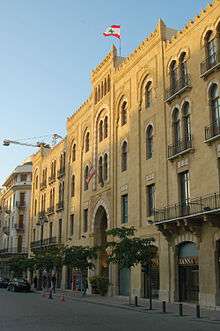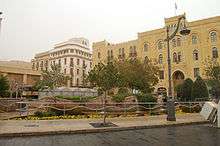Rue Weygand
Rue Weygand is a street in Beirut's Central Business District. Originally, the street was named Rue Nouvelle as it was a new thoroughfare constructed as part of a modernization plan in 1915.[1] Upon its completion, the street was renamed after Maxime Weygand, the High Commissioner of French-mandated Syria and Lebanon who served from 19 April 1923 – 29 November 1924.


Jean Lauffray, the French archeologist, revealed that Rue Weygand followed the ancient Roman decumanus.[2][3] While Roman and Byzantine mosaic floors have been found, the street predates the Roman Empire as archeological digs have also uncovered evidence that the street was a commercial hub even prior to the Hellenization of Phoenicia.[4]
Prior to the war, the number 2 tram ran from Gare du Phare to Rue de Damas via Rue Weygand.[5]
Rue Weygand is a one-way street that runs east-west, beginning at Boulevard George Haddad and turning into Rue Georges Picot that cuts through the Jewish quarter of Wadi Abu Jamil.[6] The Municipality of Beirut is located on the street along with exclusive designer shops and hotels, such as Le Gray.[7] The Beirut Souks are also located on Rue Weygand.
In Literature
- The Arms of the Mantis by Robert Charles
- "Sam Terrell was at that moment prowling the rooftop of a high rise building on the Rue Weygand."
- The Man in the Middle by Hugh Atkinson
- "Lawrence turned right into the Rue Weygand, changed down and accelerated past a crawl of Mercedes, Buicks and Cadillacs."
- Redemption: A Novel of War in Lebanon by Liston Pope
- "Ligury turned left on Rue Weygand, approaching the center."
- The Song of the Goldencocks by Margaret Donnelly
- "The taxi drove him around blocks and piles of collapsing buildings, then back to Rue Weygand, because Hamid wanted to show him a few archeological excavations that he pointed to, explaining, “Omari Grand Mosque, built over Roman temple..."
- The Tiller of Waters by Hoda Barakat
- "I went out to Rue Maarad, thinking I would go as far as Rue Weygand and from there would go home to plant the shoots before they could wilt."
See also
References
- Kassir, Debevoise, and Fisk. Beirut, page 281
- Mannheim, Ivan. Syria & Lebanon Handbook: the Travel Guide, page
- Mannheim, Ivan. Syria & Lebanon Handbook: the Travel Guide, page 45
- Mannheim, Ivan. Syria & Lebanon Handbook: the Travel Guide, page
- https://www.flickr.com/photos/26601689@N02/5497070749/
- Kassir, Debevoise, and Fisk. Beirut, page 285
- http://www.campbellgrayhotels.com/le-gray-beirut/location.html?lang=EN#/le-gray-beirut/location